
As a world-leader in #WildlifeManagement, Taronga continuously improves how we monitor #AnimalHealth & #AnimalWelfare in our zoos & our #conservation programs. This includes tackling the challenges of remotely monitoring, when we can’t have eyes & ears on the ground. #ScienceWeek 

Observing #AnimalBehaviour & doing #AnimalHealth checks is only part of the picture. New #tech4wildlife help us identify potential welfare issues in real-time, especially for animals in remote locations, or large groups, or those where immediate up-close assessment isn't possible
Taronga scientists collect and analyse data on wild and zoo-based animals using field-based observation, video footage, #drones, and #CitizenScience. From these data we gain unique insights into both fine-scale movements of individuals, and broad behavioural states of the animals
#Drone footage of zoo animals allows us to identify basic movement patterns, preferred group mates, time spent running or resting, etc. Understanding movement allows us improve enclosure or sanctuary design based on space-use & #AnimalBehaviour pattern analysis. #tech4wildlife
For wild animals, detailed info on #AnimalBehaviour patterns & locations, helps us identify key parts of habitat, like foraging grounds, or areas associated with stress-responses which may indicate #HumanWildilfeConflict. These areas become priority for #conservation intervention
• • •
Missing some Tweet in this thread? You can try to
force a refresh












